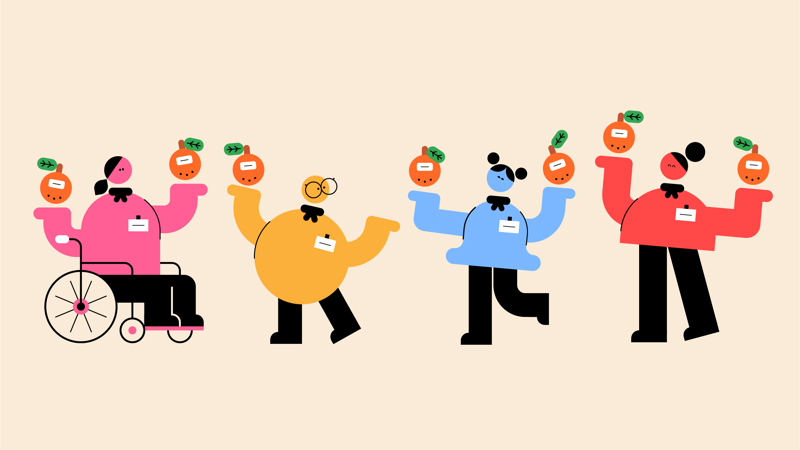
Citrus switch
You’ll need
- Pens or pencils
- Sticky labels
- Two oranges for each person (or other similar sized items like balls or cardboard tubes)
Before you begin
- Give each player a label with their name on. They should put it on somewhere it’s easy to see.
- Label the oranges too, so that for every player, there are two oranges with their name on.
Get ready to play
- Split into groups of around six players. Each group should form a circle.
- Give every player their label. They should put it on somewhere it’s easy to see.
- Give all but one player in each group two oranges (one player should have one orange). Everyone’s oranges must have another teammate’s label on – no one can have an orange with their own label on.
- Everyone should hold one orange in each hand – one person will have one empty hand.
Pass the oranges
- Each team must try to pass the oranges around, so that everyone ends up holding the orange(s) with their labels on.
- Players can only hold one orange in each hand.
- Players can only pass oranges to the people directly next to them in the circle. They can only pass an orange if the person next to them has an empty hand, to take the orange.
- Teams win when everyone in their circle is holding their own oranges.
- Don’t let the oranges go to waste! Use them in cooking, or take them home for a snack.
Reflection
This game needed you to problem-solve. What was the most difficult bit of the game? What problems did you have? How did you solve the problems? Why did you choose that method? Did you succeed first time, or did you have to try more than once? Would you change anything if you played again?
To succeed, you also needed to be a good team player. Did you listen to everyone in your team? Did everyone need to work towards the same goal? Did it work if everyone just cared about their own oranges? How did you talk to your teammates? Did anyone do anything especially helpful?
Safety
All activities must be safely managed. You must complete a thorough risk assessment and take appropriate steps to reduce risk. Use the safety checklist to help you plan and risk assess your activity. Always get approval for the activity, and have suitable supervision and an InTouch process.
- Food
Remember to check for allergies, eating problems, fasting or dietary requirements and adjust the recipe as needed. Make sure you’ve suitable areas for storing and preparing food and avoid cross contamination of different foods. Take a look at our guidance on food safety and hygiene.
- Increase the size of the teams to increase the challenge.
- Add new rules, for example making teams play the game in silence, or sitting in a straight line.
- If anyone struggles with reading or recognising letters, you could use coloured dots or pictures on the labels instead.
- If anyone is unable to use two hands, their team should sit down. Every player should mark two ‘spots’ on the floor in front of them using paper or Post-it notes. Now, oranges must sit on these ‘spots’. Players can only move oranges into an empty spot belonging to the person next to them (but they can move the oranges in any way that works for them).
- Plastic balls would work as a substitute if you are unable to use oranges.
All Scout activities should be inclusive and accessible.



